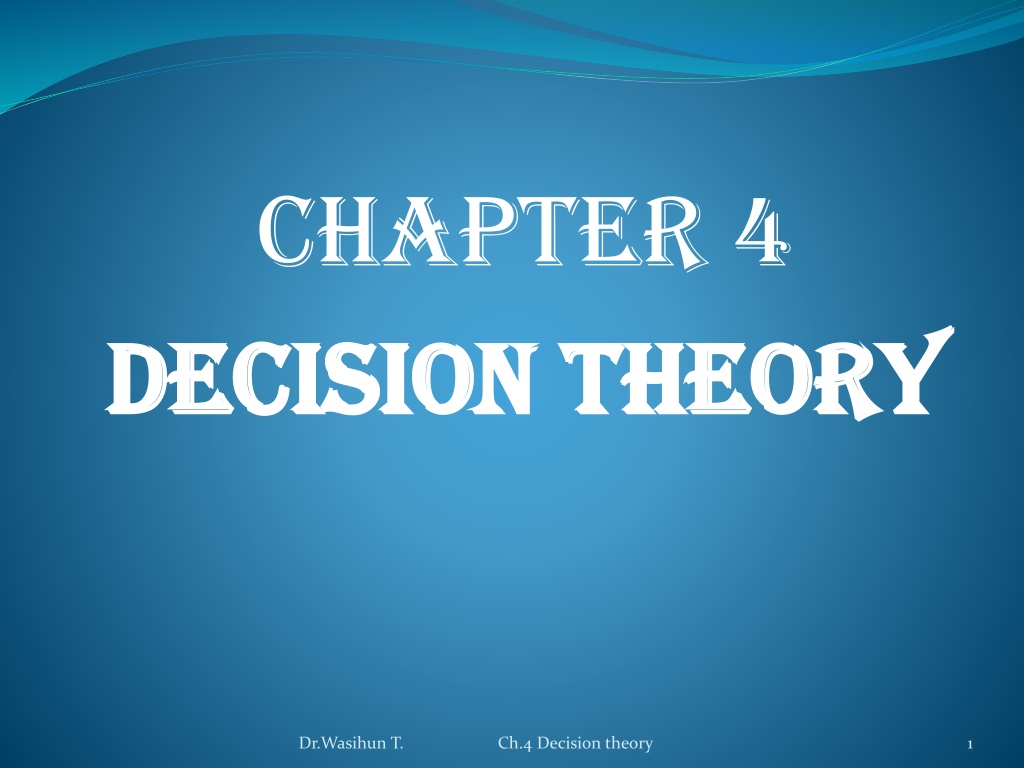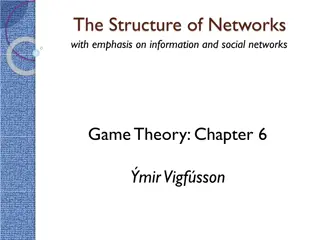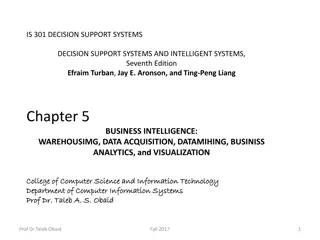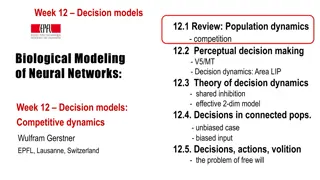Understanding Decision Theory in Business: A Comprehensive Overview
Decision theory in business involves making choices based on organizational objectives like profit maximization or cost minimization under conditions of uncertainty. This chapter covers key components such as alternatives, states of nature, payoffs, degree of certainty, and decision criteria. It explores how decision makers assess risks and uncertainties to make informed choices that align with their goals.
Download Presentation

Please find below an Image/Link to download the presentation.
The content on the website is provided AS IS for your information and personal use only. It may not be sold, licensed, or shared on other websites without obtaining consent from the author. Download presentation by click this link. If you encounter any issues during the download, it is possible that the publisher has removed the file from their server.
E N D
Presentation Transcript
Chapter 4 Decision Theory Decision Theory Dr.Wasihun T. Ch.4 Decision theory 1
4.1 Introduction The decisions are based on the criteria decided by the organization objective of the business. Example: Maximization of profit or Minimization of cost /time Many decision making situations occur under conditions of uncertainty. Example : the demand for a product may be not 100 units next week, but 50 or 200 units, depending on the market (which is uncertain). Dr.Wasihun T. Ch.4 Decision theory 2
4.2 Characteristics of Decision Theory (5) 1. List of alternatives: are a set of mutually exclusive and collectively exhaustive decisions that are available to the decision maker (some times, not always, one of these alternatives will be to donothing .) 2. States of nature: - the set of possible future conditions, or events, beyond the control of the decision maker, that will be the primary determinants of the eventual consequence of the decision. The states of nature, like the list of alternatives, must be mutually exclusive and collectively exhaustive. Dr.Wasihun T. Ch.4 Decision theory 3
Cont 3. Payoffs: - the payoffs might be profits, revenues, costs, or other measures of value. Usually the measures are financial. Usually payoffs are estimated values. The more accurate these estimates, the more useful they will be for decision making purposes and the more likely, it is that the decision maker will choose an appropriate alternative. The number of payoffs depends on the number of alternative/state of nature combination. Dr.Wasihun T. Ch.4 Decision theory 4
Cont 4. Degree of certainty: - the approach often used by a decision maker depends on the degree of certainty that exists. There can be different degrees of certainty. One extreme is complete certainty and the other is complete uncertainty. The later exists when the likelihood of the various states of nature are unknown. Between these two extremes is risk (probabilities are unknown for the states of nature). Knowledge of the likelihood of each of the states of nature can play an important role in selecting a course of active. 5. Decision criteria: - the decision maker s attitudes toward the decision as well as thedegree of certainty that surrounds a decision. Example; maximize the expected payoffs Dr.Wasihun T. Ch.4 Decision theory 5
4.3 Payoff Table A payoff table is a device a decision maker can use to summarize and organize information relevant to a particular decision. It includes a list of alternatives, the possible future states of nature, and the payoffs associated with each of the alternative/state of nature combinations. If probabilities for the states of nature are available, these can also be listed. The general format of the table is illustrated below: Dr.Wasihun T. Ch.4 Decision theory 6
Cont State of nature S1 S2 S3 Alternatives A1 A2 A3 where: Ai = the ith alternative Sj = the jth states of nature Vij = the value or payoff that will be realized if alternative i is chosen and event j occurs. v11 v21 v31 v12 v22 v32 V13 v23 v33 Dr.Wasihun T. Ch.4 Decision theory 7
4.4 Decision Making Process Identify all possible state of nature i.e events available or affecting the decision. 1. list out various course of action open to the decision maker. These finite 2. number of course of action will facilitate the decision maker to decide under controlled parameters. Identify the pay-offs for various strategic solution under all known events or 3. state of nature . Variation of acts & events will be helpful to identify the outcomes or pay-off for various combination. Decision to choose from amongst these alternative under given conditions with 4. identified pay-offs. This steps may involves the judgment or any additional information helping the decision making process. Dr.Wasihun T. Ch.4 Decision theory 8
4.5 Decision making environment Decision are made under four types of environment: 1. Decision making under condition of certainty 2. Decision making under condition of uncertainty 3. Decision making under condition of risk 4. Decision making under condition of conflict Dr.Wasihun T. Ch.4 Decision theory 9
4.5.1 Decision Making Under Certainty In this environment , only one state of nature exists for each alternative i.e there is complete certainty about the future . It is easy to analyze the situation and make good decision. Since the decision maker has perfect knowledge about the future outcomes, he simple choose the alternative having optimum payoff. Dr.Wasihun T. Ch.4 Decision theory 10
Example The following payoff table provides data about profits of the various states of nature/alternative combination. S1 S 2 S3 4 16 12 A1 A2 5 6 10 A3 -1 4 15 If we know that S2 will occur, the decision maker then can focus on the first raw of the payoff table. Because alternative A1 has the largest profit (16), it would be selected. Dr.Wasihun T. Ch.4 Decision theory 11
4.5.2 Decision making under conditions of uncertainty More than one states of nature exists but the decision maker lacks the knowledge about the probabilities of their circumstances . A few decision criteria are available which can be help to the decision maker. 1. MAXIMAX (optimistic ) Criteria The decision maker selects the decision that will result in the maximum of the maximum payoffs. The maximax is very optimistic. The decision maker assumes that the most favorable state of nature for each decision alternative will occur Dr.Wasihun T. Ch.4 Decision theory 12
Example The investor would optimistically assume that good economic conditions will prevail in the future. The best payoff for each alternative is identified, and the alternative with the maximum of these is the designated decision. S1 S2 S3 Row Maximum A1 A2 A3 -1 4 4 16 12 16*Maximum 5 6 10 10 15 15 Dr.Wasihun T. Ch.4 Decision theory 13
Cont Decision: A1 will be chosen. Note: If the pay off table consists of costs instead of profits, the opposite selection would be indicated: The minimum of minimum costs. For the subsequent decision criteria we encounter, the same logic in the case of costs can be used Dr.Wasihun T. Ch.4 Decision theory 14
2. Maximin Criteria This approach is the opposite of the previous one, i.e. it is pessimistic. This strategy is a conservative one; it consists of identifying the worst (minimum) payoff for each alternative, and, then, selecting the alternative that has the best (maximum) of the worst payoffs. In effect, the decision maker is setting a floor on the potential payoff by selecting maximum of the minimum; the actual payoff can not be less than this amount. It involves selecting best of the worst. Dr.Wasihun T. Ch.4 Decision theory 15
Example S1 S2 S3 A1 A2 A3 Decision: A2 will be chosen. 4 16 12 4 5 6 10 5*maximum -1 4 15 -1 Note: If it were cost, the conservative approach would be to select the maximum cost for each decision and select the minimum of these costs. Dr.Wasihun T. Ch.4 Decision theory 16
3. MINIMAX REGRET In order to use this approach, it is necessary to develop an opportunity loss table. The opportunity loss reflects the difference between each payoff and the best possible payoff in a column (i.e., given a state of nature). Hence, opportunity loss amounts are found by identifying the best payoff in a column and, then, subtracting each of the other values in the column from that payoff. Therefore, this decision avoids the greatest regret by selecting the decision alternative that minimizes the maximum regret. Dr.Wasihun T. Ch.4 Decision theory 17
Example S1 S2 S3 A1 A2 A3 4 16 12 5 6 10 -1 4 15 opportunity loss table S1 S2 S3 A1 A2 A3 5-4=1 16-16=0 15-12=3 3*minimum 5-5=0 16-6=10 15-10=5 10 5-(-1)=6 16-4=12 15-15=0 12 Dr.Wasihun T. Ch.4 Decision theory 18
Cont A decision maker could select an alternative in such a way as to minimize the maximum possible regret. This requires identifying the maximum opportunity loss in each row and, then, choosing the alternative that would yield the best (minimum) of those regrets. Decision: A1 will be chosen Dr.Wasihun T. Ch.4 Decision theory 19
4. Laplace (criteria of rationality)or Bayes criteria The principle of insufficient reason offers a method that incorporates more of the information. It treats the states of nature as if each were equally likely, and it focuses on the average payoff for each row, selecting the alternative that has the highest row average. Dr.Wasihun T. Ch.4 Decision theory 20
Example S1 S2 S3 S4 S5 Row average A1 A2 A3 28 28 28 28 4 23.2*maximum 5 5 5 5 28 9.6 5 5 5 25 28 9.6 Decision: A1 is selected The basis for the criterion of insufficient reason is that under complete uncertainty, the decision maker should not focus on either high or low payoffs, but should treat all payoffs (actually, all states of nature), as if they were equally likely. Averaging row payoffs accomplishes this. Dr.Wasihun T. Ch.4 Decision theory 21
5. The Hurwitz Criterion The Hurwitz criterion strikes a compromise between the maximax and maximin criterion. The principle underlying this decision criterion is that the decision maker is neither totally optimistic, nor totally pessimistic. With Hurwitz criterion, the decision payoffs are weighted by a coefficient of optimism, a measure of a decision maker s optimism. The coefficient of optimism, which is defined as , is between zero and one (0< <1). If = 1, then the decision maker is said to be completely optimistic, if = 0, then the decision maker is completely pessimistic. Given this definition, if is coefficient of optimism, 1- is coefficient of pessimism. The Hurwitz criterion requires that for each alternative, the maximum payoff is multiplied by and the minimum payoff be multiplied by 1- . Dr.Wasihun T. Ch.4 Decision theory 22
Example S1 S2 S3 Max row A1 A2 A3 If = 0.4 for the above example, A1 = (0.4x16) + (0.6x4) = 8.8 A2 = (0.4x10) + (0.6x5) = 7 A3 = (0.4x15) + (0.6x-1) = 5.6 Decision: A1 is selected 4 16 12 16 5 6 10 10 -1 4 15 15 Dr.Wasihun T. Ch.4 Decision theory 23
Cont A limitation of Hurwicz criterion is the fact that must be determined by the decision maker. Regardless of how the decision maker determines , it is still a completely a subjective measure of the decision maker s degree of optimism. Therefore, Hurwicz criterion is a completely subjective decision making criterion. Dr.Wasihun T. Ch.4 Decision theory 24
4.5.3 Decision Making Under Risk The decision making criteria just presented were based on the assumption that no information regarding the likelihood of the states of the nature was available. Thus, no probabilities of occurrence were assigned to the states of nature, except in the case of the equal likely hood criterion. It is often possible for the decision maker to know enough about the future state of nature to assign probabilities to their occurrences. Dr.Wasihun T. Ch.4 Decision theory 25
Cont The term risk is often used in conjunction with partial uncertainty, presence of probabilities for the occurrence of various states of nature. The probabilities may be subjective estimates from managers or from experts in a particular field, or they may reflect historical frequencies. If they are reasonably correct, they provide the decision maker with additional information that can dramatically improve the decision making process. Given that probabilities can be assigned, several decision criteria are available to aid the decision maker. Some of these are discussed below. Dr.Wasihun T. Ch.4 Decision theory 26
A. EXPECTED MONETARY VALUE (EMV) The EMV approach provides the decision maker with a value which represents an average payoff for each alternative. The best alternative is, then, the one that has the highest EMV. The average or expected payoff of each alternative is a weighted average: k EMVi = Pj.Vij i=1 Where: EMVi = the EMV for the ith alternative Pi = the probability of the ith state of nature Vij = the estimated payoff for alternative i under state of nature j. Note: the sum of the probabilities for all states of nature must be 1. Dr.Wasihun T. Ch.4 Decision theory 27
Example Probability 0.20 0.50 0.30 S1 S2 S3 Expected payoff A1 A2 A3 4 16 12 12.40*maximum 5 6 10 7 -1 4 15 6.3 Decision: A1 will be chosen Dr.Wasihun T. Ch.4 Decision theory 28
B. Expected Opportunity Loss (EOL) The table of opportunity loss is used rather than a table of payoffs. Hence, the opportunity losses for each alternative are weighted by the probabilities of their respective state of nature to compute a long run average opportunity loss, and the alternative with the smallest expected loss is selected as the best choice. Dr.Wasihun T. Ch.4 Decision theory 29
Example S1 S2 S3 A1 A2 A3 EOL (A1) = 0.20(1) + 0.50(0) + 0.30(3) = 1.10 *minimum EOL (A2) = 0.20(0) + 0.50(10) + 0.30(5) = 6.50 EOL (A3) = 0.20(6) + 0.50(12) + 0.30(0) = 7.20 Note: The EOL approach resulted in the same alternative as the EMV approach (Maximizing the payoffs is equivalent to minimizing the opportunity losses). 4 16 12 5 6 10 -1 4 15 Dr.Wasihun T. Ch.4 Decision theory 30
C. Expected Value of Perfect Information (EVPI) It can some times be useful for a decision maker to determine the potential benefit of knowing for certain which state of nature is going to prevail. The EVPI is the measure of the difference between the certain payoffs that could be realized under a condition involving risk. If the decision maker knows that S1 will occur, A2 would be chosen with a payoff of $5. Similarly for S2 $16 (for A1) and for S3, $15 (with A3) would be chosen. Dr.Wasihun T. Ch.4 Decision theory 31
Cont Hence, the expected payoff under certainty (EPC) would be: EPC = 0.20(5) + 0.50(16) + 0.30(15) = 13.50 The difference between this figure and the expected payoff under risk (i.e., the EMV) is the expected value of perfect information. Thus: EVPI = EPC - EMV = 13.50 -12.40 = 1.10 Note: The EVPI is exactly equal to the EOL. The EOL indicates the expected opportunityloss due to imperfect information, which is another way of saying the expected payoff that could be achieved by having perfect information. Dr.Wasihun T. Ch.4 Decision theory 32
Decision Trees It is a graphical representation of the decision process indicating decision alternatives, state of nature, probabilities attached to the states of nature and conditional benefits and loss. It consists of a network of nodes and branches. Two types of nodes are used: Decision node represented by a square a. State of nature (chance or event) node represented by a circle. b. Dr.Wasihun T. Ch.4 Decision theory 33
Decision tree format Dr.Wasihun T. Ch.4 Decision theory 34
Steps in decision tree analysis Identify the decision point and alternative course of action at each 1. decision point systematically At each point , determine the probability and payoff associated 2. with each course of action Commencing from the extreme right end , compute the expected 3. payoff(EMV) for each course of action. Choose the course of action that yield the best payoff for each of 4. the decision. Dr.Wasihun T. Ch.4 Decision theory 35
Cont 5. Proceed backwards to the next stage of decision point. 6. Repeat above steps till the first decision point is reached 7. Finally identify the course of action to be adopted from the beginning to the end under different possible outcomes for the situation as a whole. Dr.Wasihun T. Ch.4 Decision theory 36
Example Pay off table for Real Estate investment State of Nature Good economic poor economic Decision conditions conditions (Purchase) 0.6 0.4 Apartment building 50,000 30,000 Office building 100,000 -40,000 Warehouse 30,000 10,000 Required : Draw the decision tree and determine the best strategy? Dr.Wasihun T. Ch.4 Decision theory 37
Cont Apartment (0.6 building conditions (0.6) Good economic 50,0000 2 Poor economic 30,000 conditions (0.4) Office building 1 Good economic conditions (0.6) 100,00 3 ) Poor economic -40,000 conditions (0.4) Good economic conditions (0.6 30,100 Warehouse Poor economic conditions (0. 4 10,000 Dr.Wasihun T. Ch.4 Decision theory 38
Cont Determining the best decision using a decision tree involves computing the expected value at each probability node. This is accomplished by starting with the final outcomes (payoffs) and working backward through the decision tree toward node 1. First, the expected value of the payoffs is computed at each probability node. EV(node 2) = .60($ 50,000) + .40($ 30,000) = $42,000 EV(node 3) = .60($100,000) + .40($-40,000) = $44,000 EV(node 4) = .60($ 30,000) + .40($ 10,000) = $22,000 Dr.Wasihun T. Ch.4 Decision theory 39
Cont The maximum benefit accrues when you invest in office building as it give you the greatest expected value in purchase. Therefore , the stage of the decision tree would depend on the level of decision making . If there are series of decisions to be made , made say likely profit for 5 years spans, it will be a multistage decision tree case for spans of 1,2,3,4 and 5 years decisions. Dr.Wasihun T. Ch.4 Decision theory 40
end Dr.Wasihun T. Ch.4 Decision theory 41






























